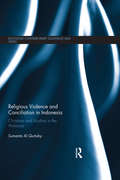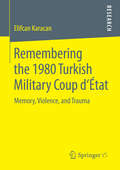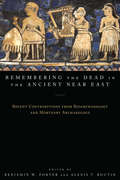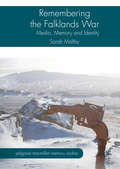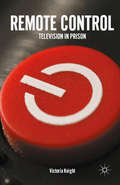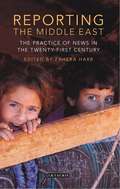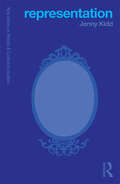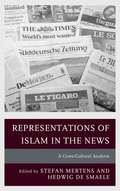- Table View
- List View
Religious Violence and Conciliation in Indonesia: Christians and Muslims in the Moluccas (Routledge Contemporary Southeast Asia Series)
by Sumanto Al QurtubyMaluku in eastern Indonesia is the home to Muslims, Protestants, and Catholics who had for the most part been living peaceably since the sixteenth century. In 1999, brutal conflicts broke out between local Christians and Muslims, and escalated into large-scale communal violence once the Laskar Jihad, a Java-based armed jihadist Islamic paramilitary group, sent several thousand fighters to Maluku. As a result of this escalated violence, the previously stable Maluku became the site of devastating interreligious wars. This book focuses on the interreligious violence and conciliation in this region. It examines factors underlying the interreligious violence as well as those shaping post-conflict peace and citizenship in Maluku. The author shows that religion—both Islam and Christianity—was indeed central and played an ambiguous role in the conflict settings of Maluku, whether in preserving and aggravating the Christian-Muslim conflict or supporting or improving peace and reconciliation. Based on extensive ethnographic fieldwork and interviews as well as historical and comparative research on religious identities, this book is of interest to Indonesia specialists, as well as academics with an interest in anthropology, religious conflict, peace and conflict studies.
Remaking History: The Past in Contemporary Historical Fictions
by Jerome De GrootRemaking History considers the ways that historical fictions of all kinds enable a complex engagement with the past. Popular historical texts including films, television and novels, along with cultural phenomena such as superheroes and vampires, broker relationships to ‘history’, while also enabling audiences to understand the ways in which the past is written, structured and ordered. Jerome de Groot uses examples from contemporary popular culture to show the relationship between fiction and history in two key ways. Firstly, the texts pedagogically contribute to the historical imaginary and secondly they allow reflection upon how the past is constructed as ‘history’. In doing so, they provide an accessible and engaging means to critique, conceptualize and reject the processes of historical representation. The book looks at the use of the past in fiction from sources including Mad Men, Downton Abbey and Howard Brenton’s Anne Boleyn, along with the work of directors such as Terence Malick, Quentin Tarantino and Martin Scorsese, to show that fictional representations enable a comprehension of the fundamental strangeness of the past and the ways in which this foreign, exotic other is constructed. Drawing from popular films, novels and TV series of recent years, and engaging with key thinkers from Marx to Derrida, Remaking History is a must for all students interested in the meaning that history has for fiction, and vice versa.
Remaking History: The Past in Contemporary Historical Fictions
by Jerome De GrootRemaking History considers the ways that historical fictions of all kinds enable a complex engagement with the past. Popular historical texts including films, television and novels, along with cultural phenomena such as superheroes and vampires, broker relationships to ‘history’, while also enabling audiences to understand the ways in which the past is written, structured and ordered. Jerome de Groot uses examples from contemporary popular culture to show the relationship between fiction and history in two key ways. Firstly, the texts pedagogically contribute to the historical imaginary and secondly they allow reflection upon how the past is constructed as ‘history’. In doing so, they provide an accessible and engaging means to critique, conceptualize and reject the processes of historical representation. The book looks at the use of the past in fiction from sources including Mad Men, Downton Abbey and Howard Brenton’s Anne Boleyn, along with the work of directors such as Terence Malick, Quentin Tarantino and Martin Scorsese, to show that fictional representations enable a comprehension of the fundamental strangeness of the past and the ways in which this foreign, exotic other is constructed. Drawing from popular films, novels and TV series of recent years, and engaging with key thinkers from Marx to Derrida, Remaking History is a must for all students interested in the meaning that history has for fiction, and vice versa.
Remaking Participation: Science, Environment and Emergent Publics
by Matthew Kearnes Jason ChilversChanging relations between science and democracy – and controversies over issues such as climate change, energy transitions, genetically modified organisms and smart technologies – have led to a rapid rise in new forms of public participation and citizen engagement. While most existing approaches adopt fixed meanings of ‘participation’ and are consumed by questions of method or critiquing the possible limits of democratic engagement, this book offers new insights that rethink public engagements with science, innovation and environmental issues as diverse, emergent and in the making. Bringing together leading scholars on science and democracy, working between science and technology studies, political theory, geography, sociology and anthropology, the volume develops relational and co-productionist approaches to studying and intervening in spaces of participation. New empirical insights into the making, construction, circulation and effects of participation across cultures are illustrated through examples ranging from climate change and energy to nanotechnology and mundane technologies, from institutionalised deliberative processes to citizen-led innovation and activism, and from the global north to global south. This new way of seeing participation in science and democracy opens up alternative paths for reconfiguring and remaking participation in more experimental, reflexive, anticipatory and responsible ways. This ground-breaking book is essential reading for scholars and students of participation across the critical social sciences and beyond, as well as those seeking to build more transformative participatory practices.
Remaking Participation: Science, Environment and Emergent Publics
by Matthew Kearnes Jason ChilversChanging relations between science and democracy – and controversies over issues such as climate change, energy transitions, genetically modified organisms and smart technologies – have led to a rapid rise in new forms of public participation and citizen engagement. While most existing approaches adopt fixed meanings of ‘participation’ and are consumed by questions of method or critiquing the possible limits of democratic engagement, this book offers new insights that rethink public engagements with science, innovation and environmental issues as diverse, emergent and in the making. Bringing together leading scholars on science and democracy, working between science and technology studies, political theory, geography, sociology and anthropology, the volume develops relational and co-productionist approaches to studying and intervening in spaces of participation. New empirical insights into the making, construction, circulation and effects of participation across cultures are illustrated through examples ranging from climate change and energy to nanotechnology and mundane technologies, from institutionalised deliberative processes to citizen-led innovation and activism, and from the global north to global south. This new way of seeing participation in science and democracy opens up alternative paths for reconfiguring and remaking participation in more experimental, reflexive, anticipatory and responsible ways. This ground-breaking book is essential reading for scholars and students of participation across the critical social sciences and beyond, as well as those seeking to build more transformative participatory practices.
Rematerialising children’s agency: Everyday practices in a post-socialist estate
by Matej BlazekThis book is a detailed study of children’s everyday practices in a small, deprived neighbourhood of post-socialist Bratislava, called Kopčany. It provides a novel empirical insight on what it is like to be growing up after 25 years of post-socialist transformations and questions the formation of children’s agency and the multitude of resources it comes from. What happens if we accept children’s practices as cornerstones of communities? What is uncovered if we examine adults' co-presence with children in everyday community spaces? With a background in youth work, the author writes from the unique position of being able to develop in-depth insights into both children’s life-worlds, and practitioners’ priorities and needs.
Remembering the 1980 Turkish Military Coup d‘État: Memory, Violence, and Trauma
by Elifcan KaracanIn her research studies, Elifcan Karacan shows the relation between trauma, violence and memory with a specific focus on the events considering the 1980 Military Coup d‘État in Turkey. Based on collective memory theories and cultural trauma theories, the author focuses on the reconstruction of the past in present times and memory practices, such as commemorations, anniversaries, construction of memory-places (museums). This book seeks for an understanding of collective memory within individual narrations and mnemonic practices by using narrative interviews and biographical case reconstruction methods.
Remembering the Dead in the Ancient Near East: Recent Contributions from Bioarchaeology and Mortuary Archaeology
by Alexis T. Boutin Benjamin W. PorterRemembering the Dead in the Ancient Near East is among the first comprehensive treatments to present the diverse ways in which ancient Near Eastern civilizations memorialized and honored their dead, using mortuary rituals, human skeletal remains, and embodied identities as a window into the memory work of past societies. In six case studies, teams of researchers with different skillsets—osteological analysis, faunal analysis, culture history and the analysis of written texts, and artifact analysis—integrate mortuary analysis with bioarchaeological techniques. Drawing upon different kinds of data, including human remains, ceramics, jewelry, spatial analysis, and faunal remains found in burial sites from across the region’s societies, the authors paint a robust and complex picture of death in the ancient Near East. Demonstrating the still underexplored potential of bioarchaeological analysis in ancient societies, Remembering the Dead in the Ancient Near East serves as a model for using multiple lines of evidence to reconstruct commemoration practices. It will be of great interest to students and scholars of ancient Near Eastern and Egyptian societies, the archaeology of death and burial, bioarchaeology, and human skeletal biology.
Remembering the Falklands War: Media, Memory and Identity (Palgrave Macmillan Memory Studies)
by Sarah MaltbyThis book offers an empirically informed understanding of how identity and agency become wholly embedded within practices of media-remembering. It draws upon data collected from the British military, the BBC and Falkland Islanders during the 30th Anniversary of the Falklands war to uniquely offer multiple perspectives on a single ‘remembering’ phenomenon. The study offers an analysis of the convergence, interconnectedness and interdependence of media and remembering, specifically the production, interpretation and negotiation of remembering in the media ecology. In so doing it not only examines the role of media in the formation and sustaining of collective memory but also the ways those who remember or are remembered in media texts become implicated in these processes.
Remote Control: Television in Prison
by V. KnightIn-cell television is now a permanent feature of prisons in England and Wales, and a key part of the experience of modern incarceration. This sociological exploration of prisoners' use of television offers an engaging and thought provoking insight into the domestic and everyday lives of people in prison - with television close at hand. Victoria Knight explores how television contributes to imprisonment by normalising the prison cell. In doing so it legitimates this space to hold prisoners for long periods of time, typically without structured activity. As a consequence, television's place in the modern prison has also come to represent an unanticipated resource in the package of care for prisoners.This book uncovers the complex and rich emotive responses to prison life. Dimensions of boredom, anger, frustration, pleasure and happiness appear through the rich narratives of both prisoners and staff, indicating the ways institutions and individuals deal with their emotions. It also offers an insight into the unfolding future of the digital world in prisons and begins to consider how the prisoner can benefit from engagement with digital technologies. It will be of great interest to practitioners and scholars of prisons and penology, as well as those interested in the impact of television on society.
Reporting Dangerously: Journalist Killings, Intimidation and Security
by Simon Cottle Nick Mosdell Richard SambrookMore journalists are being killed, attacked and intimidated than at any time in history. Reporting Dangerously: Journalist Killings, Intimidation and Security examines the statistics and looks at the trends in journalist killings and intimidation around the world. It identifies what factors have led to this rise and positions these in historical and global contexts. This important study also provides case studies and first-hand accounts from journalists working in some of the most dangerous places in the world today and seeks to understand the different pressures they must confront. It also examines industry and political responses to these trends and pressures as well as the latest international initiatives aimed at challenging cultures of impunity and keeping journalists safe. Throughout, the authors argue that journalism contributes a vital if often neglected role in the formation and conduct of civil societies. This is why reporting from ‘uncivil’ places matters and this is why journalists are often positioned in harm’s way. The responsibility to report in a globalizing world of crises and human insecurity, and the responsibility to try and keep journalists safe while they do so, it is argued, belongs to us all.
Reporting The Middle East: The Practice Of News In The Twenty-first Century (PDF)
by Zahera HarbHow does the media cover the Middle East? Through a detailed country-by-country approach, this book provides a detailed analysis of the complexities of reporting from the Arab world. Each chapter provides an overview of the country in question, including the political context, relationship to international politics, and the key features that are most frequently covered in Western media. The author explores how the media can be used to serve particular political agendas on both a regional and international level. Zahera Harb also considers the changes to the media landscape following the growth of digital and social media, showing how access to the media is no longer restricted to state or elite actors. By studying coverage of the Middle East from a whole range of news providers, this book shows how news formats and practices may be defined and shaped differently by different nations. It will be essential reading for scholars and practitioners of journalism, especially those focusing on the Arab world.
Reporting Thailand's Southern Conflict: Mediating Political Dissent (Rethinking Southeast Asia)
by Phansasiri KularbSince 2004, Thailand’s southern border provinces have been plagued by violence. There are a wide array of explanations for this violence, from the revival of Malay nationalist movements and the influence from the global trend of radical Islam, to the power play among the regional underground crime syndicates, politicians, and state authorities. The disparate interpretations signal the dynamic and complex discursive contention of this damaging and enduring conflict, and this book looks at how this is played out in the Thai media, and with what possible consequences. In analysing the southern conflict coverage, the book presents the deficiencies in news coverage, as produced by four news organisations of different natures across a seven-year review period, and discusses the professional practices that hinder journalism from serving as a fair arena for healthy and rational democratic debates. Based on in-depth interviews with news workers, it argues that Thai journalism is not always monolithic and static, as shown in the discursive shifts in news content, the variations of journalistic practices and news workers’ disparate stances on the conflict. The book goes on to highlight the less immediately apparent difficulties of political conflict reporting, such as the subtle patterns of intimidation and media manipulation, as well as the challenges of countering socially-prevailing hegemonic beliefs in Thai society. Exploring the political contingencies and socio-cultural influences at play, this book provides an in-depth study of journalism’s role in politics in Thailand, and is of interest to students and scholars of Southeast Asian Politics, Media Studies and Peace and Conflict Studies.
Reporting Thailand's Southern Conflict: Mediating Political Dissent (Rethinking Southeast Asia)
by Phansasiri KularbSince 2004, Thailand’s southern border provinces have been plagued by violence. There are a wide array of explanations for this violence, from the revival of Malay nationalist movements and the influence from the global trend of radical Islam, to the power play among the regional underground crime syndicates, politicians, and state authorities. The disparate interpretations signal the dynamic and complex discursive contention of this damaging and enduring conflict, and this book looks at how this is played out in the Thai media, and with what possible consequences. In analysing the southern conflict coverage, the book presents the deficiencies in news coverage, as produced by four news organisations of different natures across a seven-year review period, and discusses the professional practices that hinder journalism from serving as a fair arena for healthy and rational democratic debates. Based on in-depth interviews with news workers, it argues that Thai journalism is not always monolithic and static, as shown in the discursive shifts in news content, the variations of journalistic practices and news workers’ disparate stances on the conflict. The book goes on to highlight the less immediately apparent difficulties of political conflict reporting, such as the subtle patterns of intimidation and media manipulation, as well as the challenges of countering socially-prevailing hegemonic beliefs in Thai society. Exploring the political contingencies and socio-cultural influences at play, this book provides an in-depth study of journalism’s role in politics in Thailand, and is of interest to students and scholars of Southeast Asian Politics, Media Studies and Peace and Conflict Studies.
Reporting the Middle East: The Practice of News in the Twenty-First Century (International Media and Journalism Studies)
by Zahera HarbHow do the media cover the Middle East? Through a country-by-country approach, this book provides detailed analysis of the complexities of reporting from the Arab World. Each chapter provides an overview of a country, including the political context, relationships to international politics and the key elements relating to the place as covered in Western media. The authors explore how the media can be used to serve particular political agendas on both a regional and international level. They also consider the changes to the media landscape following the growth of digital and social media, showing how access to the media is no longer restricted to state or elite actors. By studying coverage of the Middle East from a whole range of news providers, this book shows how news formats and practices may be defined and shaped differently by different nations. It will be essential reading for scholars and practitioners of journalism, especially those focusing on the Arab World.
Representation (Key Ideas In Media And Cultural Studies (PDF))
by Jenny KiddWritten especially for undergraduate students, Representation synthesises and updates our understandings of representation - and the tools for its analysis - for use in the new mediascape. Jenny Kidd uses an engaging range of current examples and a lively style to explore a number of key questions reflecting existing and contemporary debates about representation. These key questions include: Who ‘owns’ and manages representations? Whose realities are foregrounded, and whose are consigned to invisibility? To what extent are increased opportunities for self-representation altering the landscape? And what happens to representation within the noisy, playful and often subversive communications of the Internet? Kidd considers the political, social and cultural importance of representation across a broad spectrum of cultural and creative industries. This examination of the relationship between media/cultural representations and the construction of reality, identity and society makes it an ideal text for students that need to get to grips with this core thematic of media and cultural studies.
Representation (Key Ideas in Media & Cultural Studies)
by Jenny KiddWritten especially for undergraduate students, Representation synthesises and updates our understandings of representation - and the tools for its analysis - for use in the new mediascape. Jenny Kidd uses an engaging range of current examples and a lively style to explore a number of key questions reflecting existing and contemporary debates about representation. These key questions include: Who ‘owns’ and manages representations? Whose realities are foregrounded, and whose are consigned to invisibility? To what extent are increased opportunities for self-representation altering the landscape? And what happens to representation within the noisy, playful and often subversive communications of the Internet? Kidd considers the political, social and cultural importance of representation across a broad spectrum of cultural and creative industries. This examination of the relationship between media/cultural representations and the construction of reality, identity and society makes it an ideal text for students that need to get to grips with this core thematic of media and cultural studies.
Representation (Key Ideas in Media & Cultural Studies)
by Jenny KiddWritten especially for undergraduate students, Representation synthesises and updates our understandings of representation - and the tools for its analysis - for use in the new mediascape. Jenny Kidd uses an engaging range of current examples and a lively style to explore a number of key questions reflecting existing and contemporary debates about representation. These key questions include: Who ‘owns’ and manages representations? Whose realities are foregrounded, and whose are consigned to invisibility? To what extent are increased opportunities for self-representation altering the landscape? And what happens to representation within the noisy, playful and often subversive communications of the Internet? Kidd considers the political, social and cultural importance of representation across a broad spectrum of cultural and creative industries. This examination of the relationship between media/cultural representations and the construction of reality, identity and society makes it an ideal text for students that need to get to grips with this core thematic of media and cultural studies.
Representations of Black Women in the Media: The Damnation of Black Womanhood (Routledge Transformations in Race and Media)
by Marquita Marie GammageIn 1920 W.E.B. Du Bois cited the damnation of women as linked to the devaluation of motherhood. This dilemma, he argues, had a crushing blow on Black women as they were forced into slavery. Black womanhood, portrayed as hypersexual by nature, became an enduring stereotype which did not coincide with the dignity of mother and wife. This portrayal continues to reinforce negative stereotypes of Black women in the media today. This book highlights how Black women have been negatively portrayed in the media, focusing on the export nature of media and its ability to convey notions of Blackness to the public. It argues that media such as rap music videos, television dramas, reality television shows, and newscasts create and affect expectations of Black women. Exploring the role that racism, misogyny and media play in the representation of Black womanhood, it provides a foundation for challenging contemporary media’s portrayal of Black women.
Representations of Black Women in the Media: The Damnation of Black Womanhood (Routledge Transformations in Race and Media #5)
by Marquita Marie GammageIn 1920 W.E.B. Du Bois cited the damnation of women as linked to the devaluation of motherhood. This dilemma, he argues, had a crushing blow on Black women as they were forced into slavery. Black womanhood, portrayed as hypersexual by nature, became an enduring stereotype which did not coincide with the dignity of mother and wife. This portrayal continues to reinforce negative stereotypes of Black women in the media today. This book highlights how Black women have been negatively portrayed in the media, focusing on the export nature of media and its ability to convey notions of Blackness to the public. It argues that media such as rap music videos, television dramas, reality television shows, and newscasts create and affect expectations of Black women. Exploring the role that racism, misogyny and media play in the representation of Black womanhood, it provides a foundation for challenging contemporary media’s portrayal of Black women.
Representations of Childhood in American Modernism
by Michelle H. PhillipsThis book documents American modernism’s efforts to disenchant adult and child readers alike of the essentialist view of childhood as redemptive, originary, and universal. For James, Barnes, Du Bois, and Stein, the twentieth century’s move to position the child at the center of the self and society raised concerns about the shrinking value of maturity and prompted a critical response that imagined childhood and children’s narratives in ways virtually antagonistic to both. In this original study, Michelle H. Phillips argues that American modernism’s widespread critique of childhood led to some of the period’s most meaningful and most misunderstood experiments with interiority, narration, and children’s literature.
Representations Of Islam In The News: A Cross-cultural Analysis (PDF)
by Stefan Mertens Elien Kok Lut Lams Stefanie Nijs Koenraad Du Pont Elizabeth Poole Roza Tsagarousianou Chris Verschooten Leen D'Haenens Hedwig De Smaele David Abadi Arshad Amanullah Anna Berbers Dorien De Booser Jan Ceuppens Rozane De Cock Elke Ichau Joyce KoemanThe representation of Islam is unquestionably a critical test for comparing journalistic reporting across countries and cultures. The Islamic religion has weight in international reporting (defining what we termed "foreign Islam"), but it is also the religion of numerically important minority groups residing in Europe ("national Islam"). The first part of the book is "setting the scene. " Three chapters provide insights in dominant patterns of the representation of Islam as detected by various authors and studies involved with Islam representation in Europe. Part two, the core section of the book, contributes to the development of the field of comparative journalism studies by comparing several countries and six media systems in Western Europe: the Dutch-speaking part of Belgium (Flanders), the French-speaking part of Belgium (Wallonia), the Netherlands, France, Germany, and the U. K. Part three of this book presents two reception studies, one qualitative and the other quantitative. Equally important, as the bulk of attention goes to Western Europe, is the extension towards the representation of Muslims and Islam outside Western Europe. Part four of the book is devoted to the representation of Islam in some of the so-called BRICs-countries: Russia, China, and India.
Representing the Holocaust: History, Theory, Trauma
by Dominick LaCapraDefying comprehension, the tragic history of the Holocaust has been alternately repressed and canonized in postmodern Western culture. Recently our interpretation of the Holocaust has been the center of bitter controversies, from debates over Paul de Man's collaborationist journalism and Martin Heidegger’s Nazi past to attempts by some historians to downplay the Holocaust’s significance. A major voice in current historiographical discussions, Dominick LaCapra brings a new clarity to these issues as he examines the intersections between historical events and the theory through which we struggle to understand them.In a series of essays—three published here for the first time—LaCapra explores the problems faced by historians, critics, and thinkers who attempt to grasp the Holocaust. He considers the role of canon formation and the dynamic of revisionist historiography, as well as critically analyzing responses to the discovery of de Man’s wartime writings. He also discusses Heidegger’s involvement with National Socialism, and he sheds light on postmodernist obsessions with such concepts as loss, agora, dispossession, deferred meaning, and the sublime. Throughout, LaCapra demonstrates that psychoanalysis is not merely a psychology of the individual but that its concepts have sociocultural dimensions and can help us perceive the relationship between the present and the past. Many of our efforts to comprehend the Holocaust, he shows, continue to suffer from the traumatizing effects of its events and require a "working through" of that trauma if we are to gain a more profound understanding of the meaning of the Holocaust.
Representing the Nation: Heritage, Museums, National Narratives, and Identity in the Arab Gulf States (Routledge Research in Museum Studies)
by Pamela Erskine-Loftus Victoria Penziner Hightower Mariam Ibrahim Al-MullaThe 1970s saw the emergence and subsequent proliferation across the Arabian Peninsula of ‘national museums’, institutions aimed at creating social cohesion and affiliation to the state within a disparate population. Representing the Nation examines the wide-ranging use of exhibitionary forms of national identity projection via consideration of their motivations, implications (current and future), possible historical backgrounds, official and unofficial meanings, and meanings for both the user/visitor and the multiple creators. The book responds to, due to the importance placed on tradition, heritage and national identity across all the states of the Peninsula, and the growth of re-imagined and new museums, the need for far greater discussion and research in these areas.
Representing the Nation: Heritage, Museums, National Narratives, and Identity in the Arab Gulf States (Routledge Research in Museum Studies)
by Pamela Erskine-Loftus Mariam Ibrahim Al-Mulla Victoria HightowerThe 1970s saw the emergence and subsequent proliferation across the Arabian Peninsula of ‘national museums’, institutions aimed at creating social cohesion and affiliation to the state within a disparate population. Representing the Nation examines the wide-ranging use of exhibitionary forms of national identity projection via consideration of their motivations, implications (current and future), possible historical backgrounds, official and unofficial meanings, and meanings for both the user/visitor and the multiple creators. The book responds to, due to the importance placed on tradition, heritage and national identity across all the states of the Peninsula, and the growth of re-imagined and new museums, the need for far greater discussion and research in these areas.
